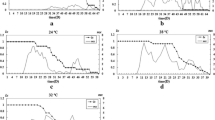Abstract
The life cycle of the carob moth,Spectrobates (= Ectomyelois) ceratoniae (Zeller), was examined on stored almonds held at 26±1°C and 70±5% relative humidity. Oviposition on almonds averaged 113 ± 5.3 eggs per female. Average adult longevity of the female and male was 5.7 (max. = 10) and 4.6 (max. = 9) days, respectively. In experiments in glass jars, 85.5% of the eggs were laid on almonds, and the remainder on filter paper, the wall of the jars, or on petri dishes. Survival of larval and pupal stages was lowest on almonds having cracked shells and highest on chopped almonds. Newly hatched and 15-day-old larvae were not able to penetrate sound in-shell almonds. Mean development time from egg to adult was 45.2 days on chopped almonds, 55.3 on shelled almonds, and 61.6 on almonds having cracked shells. Calculations of the intrinsic rate of natural increase revealed the potential danger of increase inS. ceratoniae populations when they infest stored almonds.
Similar content being viewed by others
References
Andrewartha, H.G. and Birch, L.C. (1964) The Distribution and Abundance of Animals. The University of Chicago Press, Chicago, IL.
Ashman, F. (1968) The control of infestation in carobs (Ceratonia siliqua L.) with special reference to Cyprus. Rep. Int. Conf. Stored Prod. (Paris).E.P.P.O. Publ. Ser. A 46E:117–120.
Calderon, M., Navarro, S. and Donahaye, E. (1969)Ectomyelois ceratoniae (Zell.) (Lep., Phycitidae), a major pest of stored almonds in Israel.J. stored Prod. Res. 5:427–428.
Cox, P.D. (1976) The influence of temperature and humidity on the life cycle ofEctomyelois ceratoniae (Zeller) (Lepidoptera: Phycitidae).J. stored Prod. Res. 12:111–117.
Cox, P.D. (1979) The influence of photoperiod on the life-cycle ofEctomyelois ceratoniae (Zeller) (Lepidoptera: Pyralidae).J. stored Prod. Res. 15:111–115.
Daumal, J., Jourdheuil, P. and Marro, J.P. (1973) Acclimation, sur la côte méditerranéene Francaise, dePhanerotoma flavitestacea Fischer (Hymenoptera, Braconidae), parasite d’Ectomyelois ceratoniae Zell. (Lepid., Pyralidae).Annls Zool.-Ecol. anim. 5(4):593–608.
Doumandji, S. (1978) Contribution à l’étude biologique de la Pyrale des caroubes,Ectomyelois ceratoniae. Annls Inst. natn. agron.8(5):53–64.
Eichlin, I.D. (1982) Carob moth in California: New State record.Memo. Calif. Dep. Fd Agric. Nov. 26, 1982.
Gothilf, S. (1964) The carob moth (Ectomyelois ceratoniae (Zeller)) in Israel. Ph.D. thesis, Hebrew University of Jerusalem, Jerusalem, Israel. (Hebrew, with English summary)
Gothilf, S. (1968) The biology of the carob moth,Ectomyelois ceratoniae (Zell.), in Israel. I. Mass culture on artificial diet.Israel J. Ent. 3:109–118.
Gothilf, S. (1969) The biology of the carob moth,Ectomyelois ceratoniae (Zell.), in Israel. II. Effect of food, temperature and humidity on development.Israel J. Ent. 4:195–202.
Gothilf, S. (1970) The biology of the carob moth,Ectomyelois ceratoniae (Zell.), in Israel. III. Phenology on various hosts.Israel J. Ent. 5:161–170.
Gothilf, S. (1984) Biology ofSpectrobates ceratoniae on almonds in Israel.Phytoparasitica 12:77–87.
Howe, R.W. (1965) A summary of estimates of optimal and minimal conditions for population increase of some stored products insects.J. stored Prod. Res. 1:177–184.
Krasil’nikova, G.A. (1966) Conditions promoting adaptation of some Pyralids to synan-thropism.Ent. Obozr. 45:763–773 (in Russian). (English translation inEnt. Rev. Wash. 145:430-435.)
Michael, P. (1968) The carob moth.J. Agric. west. Aust. 9:81–82.
Piguet, P. (1960) Les ennemis animaux des agrumes en Afrique du Nord. Ed. Société Shell Algérie.
Tokmakoglu, C., Soylu, O.Z. and Devecioglu, H. (1967)Myelois ceratoniae (Zell.) in biolojisi ve mucadele metodlari uzerinde arastirmalar. [The biology ofMyelois ceratoniae Zeller and research on the control methods.]Bitki Koruma Bult. 7(3):91–106.
Author information
Authors and Affiliations
Rights and permissions
About this article
Cite this article
Navarro, S., Donahaye, E. & Calderon, M. Development of the carob moth,Spectrobates ceratoniae, on stored almonds. Phytoparasitica 14, 177–186 (1986). https://doi.org/10.1007/BF02980485
Received:
Revised:
Issue Date:
DOI: https://doi.org/10.1007/BF02980485




